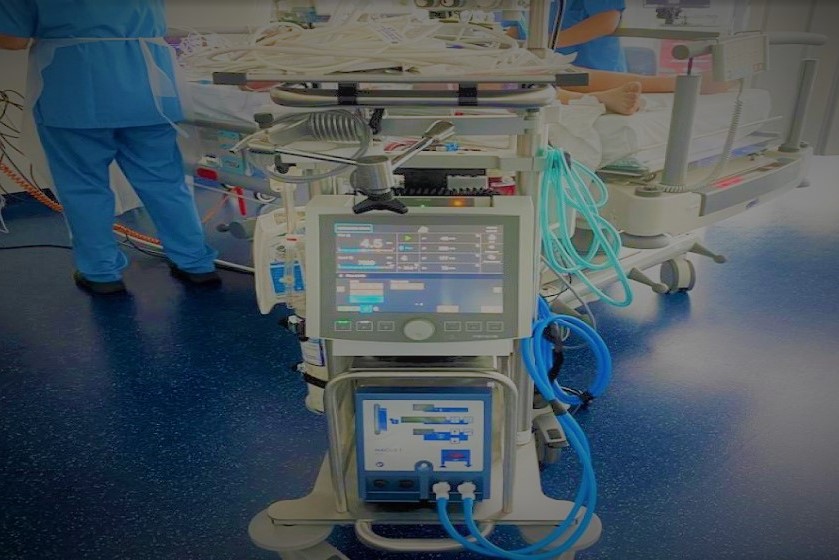
ECMO: how it works and its usefulness explained to the citizen
ECMO is an extracorporeal circulation tool that can save the lives of children with severe heart or lung failure
ECMO (ExtraCorporeal Membrane Oxygenation) or ECLS (ExtraCorporeal Life Support) is an extracorporeal circulation technique used temporarily when patients have severe, life-threatening heart and/or respiratory failure.
ECMO: How does it work?
ExtraCorporeal Membrane Oxygenation is a heart-lung machine that replaces cardiac and/or respiratory function.
The ECMO machine is similar to, but not the same as, the one used during cardiac surgery.
It works with a pump that draws blood from the patient, places it inside an ‘artificial lung’, where carbon dioxide is removed from the blood and oxygen is added (oxygenation process).
The blood is then heated and returned to the patient’s body.
Blood is always taken from the venous circulation.
The return can take place either through the venous blood vessels (venous-venous ECMO) or through the arterial blood vessels (venous-arterial ECMO).
The cannulae used can be placed percutaneously (like a normal needle-cannula) or surgically, with a small operation at the patient’s bedside.
What is ECMO used for?
ExtraCorporeal Membrane Oxygenation is a treatment reserved for patients with reversible heart or lung disease that, if left untreated, has a probability of death of more than 80%.
It is used when all other medical interventions fail.
The ECMO machine does not cure the heart or lungs, but “takes its time” and allows the diseased organs to gradually regain their function.
Some of the diseases for which paediatric patients need ECMO are:
- Particularly severe bacterial or viral pneumonias (ARDS from Acute Respiratory Distress Syndrome);
- Septic shock;
- Congenital heart disease;
- Persistent Pulmonary Hypertension of the Newborn (PPHN)
- Congenital diaphragmatic hernia;
- Alveolar haemorrhage;
- Severe asthma;
- Inability to wean from extracorporeal circulation following surgery to correct a congenital heart condition.
The period in ECMO:
Unlike during heart-lung machine interventions, which allow care for a few hours, patients on ECMO may be cared for for a period of time ranging from a few days to several weeks.
Deep sedation may be necessary in the first few days to improve the effectiveness of ECMO.
Sedation may be progressively reduced over time, but not abolished completely, to ensure the best physical and mental comfort for the patient.
Lung secretions are removed by aspirations approximately every 12 hours.
The care may be supplemented by motor and respiratory physiotherapy.
During this period, the patient’s vital functions must be supported:
- Nutrition: The ECMO patient receives all nutrients either parenterally (intravenous nutrition) or enterally via a nasogastric tube;
- Kidney function: the patient’s diuresis is constantly monitored and can be stimulated with medication. When the kidneys are not able to function properly, the patient is put on dialysis, via an artificial kidney that removes excess fluid;
- Medications: ECMO care involves the use of many medications, such as:
– Antibiotics, to slow or stop bacterial infections;
– Heparin, to prevent blood clotting;
– Opioids, to reduce pain;
– Sedatives, to decrease anxiety by inducing hypnosis;
– Miorisol, to cause muscle relaxation and thus decrease the amount of oxygen used by the body;
– Diuretics, to increase the amount of urine eliminated by the kidneys (diuresis);
– Inotropes, to improve the pumping function of the heart.
What are the risks associated with ECMO?
ExtraCorporeal Membrane Oxygenation is an invasive procedure that aids and supplements the function of vital organs.
Therefore, it is not without risks.
The biggest risk for ECMO patients is bleeding, which can occur due to the use of heparin, a drug that makes the blood thinner.
On the other hand, heparin is indispensable because it allows the oxygenator to work better and prevents the formation of clots within the circuit.
Another risk is gas emboli, air bubbles that can block the flow of blood within a blood vessel.
After ECMO:
Once disconnected from the ECMO machine, the patient stays attached to the ventilator until they are able to breathe on their own again.
This time varies from patient to patient and may take from a few days to several weeks.
Read Also:
Emergency Live Even More…Live: Download The New Free App Of Your Newspaper For IOS And Android
Policlinico Umberto I: Covid-19 Survivor Gives Birth In Extracorporeal Circulation (ECMO)
Post-Arrest Temperature Management In Children


